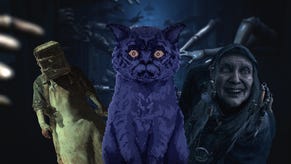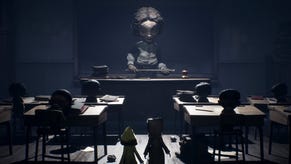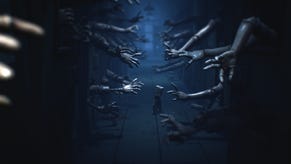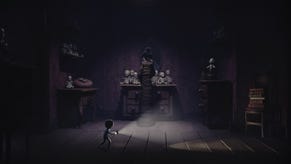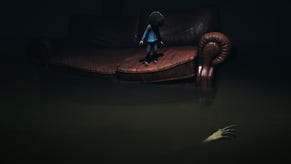How Little Nightmares' horrible characters were animated
The long arm of the maw
This is The Mechanic, where Alex Wiltshire invites developers to discuss the inner workings of their games. This time, Little Nightmares [official site].
The figures you encounter in Little Nightmares are grotesque. Disproportioned and baggy in places they shouldn’t be, the way they look is one thing, but it’s the way they move that really clinches the deal. Their staggering, shuffling and lumbering captures the flavour of the Czech stop-motion cartoons I spent a great deal of my childhood feeling unnerved by. They’re great.
It wasn’t easy to reach that special state of uncanniness, especially for a small team working on its first original game, but developer Tarsier Studios started in just the right place:
THE MECHANIC: Avoiding Pixar
Spoilers lie ahead, obv! No story secrets as such, though, just showing several scenes from throughout the game.
“We didn’t want Pixar animation, perfect fluid motion and stuff like that,” animator Mattias Göransson tells me. “It was nice when it wasn’t perfect motion, when it was crooked in some ways, and they were eerie to watch.”
Instead of looking at the exaggerated stretching and squashing of most Pixar and CG animation today, Tarsier art director Per Bergman and lead animator Marcus Ottvall first started collating a set of gifs of horror scenes that they liked. “It was a really creepy folder to look into,” says Ottvall.
And as the collection grew, they found three patterns. There were old stop-motion children’s films with things like dolls with human faces. There were old horror films. “With the cheesy movement,” says Ottvall, like Nightmare on Elm Street. In fact, the scene in which Freddy Krueger appears in an alley with incredibly long arms and scrapes his claws along the fence directly inspired Little Nightmares’ Janitor character. “We liked how robotic and cheesy it is; they couldn’t make them very well, but it also gave this creepy feeling.” The last pattern was Japanese horror and anime. The team liked the way they make horrible things like the figure that haunts Ring somehow graceful, instilling a sense of respect in the viewer.
You can see each of these broad influences in the way Little Nightmares’ cast moves, their awkwardness offset by a weird elegance. Which makes Göransson and Ottvall’s work (along with some animation by cinematic artist Patrik Johansson) all the more impressive, given the bodies they had to animate. How do you create a walk for a sightless figure with a huge head, incredibly short legs and incredibly long arms? “I think both of us cringe a little bit inside when we hear the Janitor,” says Ottvall.
“So many issues, so many arms clipping through walls,” says Göransson.
Today, all they can see are the bugs and problems, but the Janitor is probably the most disconcerting member of Little Nightmares’ cast, cocking its head when it hears you before reaching and feeling around for your body.
Because of its odd form, the Janitor doesn’t work in the typical way games animate characters. If you were to open player character Six’s files in the animation software Maya, you’d see her running on the spot, her animation looping, ready for the game to move her model around the room as you control her. But the Janitor’s animation is based on a system called root motion, in which the animation physically moves the model in space instead of playing out on the spot, every 90 degree and 180 degree turn prefabricated by Göransson. If you opened the Janitor’s model in Maya, it would move position as his routines play out.
Working this way gave some headaches, but it also gave Göransson greater control over how the Janitor moves through the levels. But even then, the Janitor dictated what kinds of space he can occupy. His model wasn’t ready to test in environments before they were built so once he was completed the levels had to be tweaked so he’d fit in them.
It was the arms that were the real issue. “We went back and forth about whether it was worth him having these long arms, because they were such a struggle to work with,” says Ottvall. His elbows kept clipping through walls, causing the team to need to give him a special animation to tuck them in when he’s close to something. “The programmer who worked with me on the Janitor, he’s grumpy about those long arms,” says Göransson.
Many animations started out as rough concepts, though, allowing quick and dirty ideas to be tried out. “I added a lot of temporary bones and joints; nothing you would want to work with, nothing you would be proud of handing over to someone else,” says Ottvall. Here’s one for the chef, followed by its appearance in the final game:
“It’s satisfying to work with because you know you can just throw it away. It’s nothing that has to work correctly; you can put some lighting in, make it look scary and cool, and you get a lot of data from that from the creative leads and go from there.”
Outside the animation itself, one of the striking things about Little Nightmares is its use of physics. They add a slice of grounded reality to the animation’s oddness, often serving to heighten the effect. Its physics feel heavy, things bouncing with a leaden thud, a sense that came from the full team, from art to programming, working together to define the parameters.
But there are other physics systems going on, too. One allows the enemies to grab Six. Ottvall and Göransson used IKinema, what’s called a full-body IK solver, which calculates the movements for reaching out an arm to connect with Six, whether she’s on the floor or on a ledge above, drawing the arm, shoulders and body towards her to make the movement look more convincing.
Their use of IKinema began with Six herself. IK systems are often used to plant game characters’ feet on the ground, posing legs, hips and body to fit the lay of the land. For Six, it was useful for precisely moving her hands and feet as she climbs. “I would like to have used it more when she’s climbing,” says Ottvall. “We had some scenes where she could climb some really weird stuff and it would look really nice, but we didn’t have time to put that in, which was a little bit of a shame.”
Six is an agile little thing, but maintains a little momentum, too. That feel, where she can turn on a sixpence but needs a moment of recovery from a sudden stop, came initially from the belief that some of the tension in horror games comes from sluggish controls. Tarsier were looking at Resident Evil and Silent Hill, “Which had such sluggish controls that it was impossible to hit anything,” Ottvall says. “It makes it scary, but I think it was OK to do that then, but I don’t think it’s OK to do that now.”
So they changed to snappy 3D platformer-style controls, because you spend a lot of time jumping and climbing, and avoiding murderous chefs. “You’re a little kid, a rat in his kitchen, and you need something to work with. It’s your weapon, essentially, that you’re small. It’s your only superpower.” But when they realised that snappiness lost some of the tension, they brought back some vulnerability. “We take control away for a little moment, to add those moments where it looks like she struggles a little bit. But we wanted her to be as snappy as possible at other times.”
Physics pops up in some unexpected places, too. For example, when the Chefs throw wine bottles at Six. “That was just me trying something out,” says Göransson. “It’s not a special tech. I was thinking maybe if I attach a bottle to his hand and release it at the right moment, maybe it flies away.” He laughs. “I talked about it with Jonas, the programmer, and he said, ‘No, don’t go down that road.’ And I said, ‘I can do it, I can do it!’ And it turned out well.”
And sometimes it looks like physics are going on when they’re not. The food the Guests guzzle towards the end of the game looks like it’s entirely dynamic, but it was animated by Göransson, relying on the Guest eating animation and the food animation starting at precisely the same second.
The result is a blend of the simulated and the hand-animated. The thrill of seeing Little Nightmares exists in the space between hyper-real and the fabricated, and between high-tech effects and small-team practicality. It’s a long way from the glossiness of Pixar and it’s all the better for it.
“‘It looks nice, but I don’t know why’ is the way I wanted it to be,” says Ottvall. “At least in this game. It’s about the atmosphere and not breaking it, always having that bit of tension. And even though the characters look weird and a little bit funny, you feel some kind of respect for them.”


